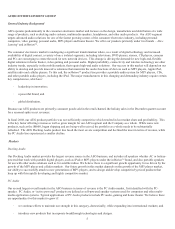Plantronics 2008 Annual Report Download - page 21
Download and view the complete annual report
Please find page 21 of the 2008 Plantronics annual report below. You can navigate through the pages in the report by either clicking on the pages listed below, or by using the keyword search tool below to find specific information within the annual report.15
xcompetition may continue to increase in AEG’s markets more than we expect;
xmeeting the spring and fall market windows for AEG products;
xdifficulties retaining or obtaining shelf space for these products in our sales channel;
xdifficulties retaining or improving the brand recognition associated with the Altec Lansing brand during the turnaround;
xdifficulties in integration of the operations, technologies, and products of Altec Lansing. We have transitioned a
significant portion of Altec Lansing’s operations onto our ERP system; however, we have not completed our integration
effort. There has been a significant cost to implement new systems and business processes. We anticipate that there will
continue to be significant business processes and internal controls which will change as a result of the integration.
Mergers and acquisitions, particularly those of technology companies, are inherently risky, and no assurance can be given that this or
any future acquisitions will be successful and will not materially adversely affect our business, operating results or financial condition.
We must also manage any acquisition-related growth effectively. In fiscal 2007 and 2008, we incurred significant losses from the
AEG business. If the anticipated future results of this business do not materialize as expected or if we miss our internal milestones in
the turnaround, goodwill and other intangible assets which were recorded as a result of the acquisition could become impaired and
could result in write-offs which would negatively impact our operating results.
If we do not match production to demand, we may lose business or our gross margins could be materially adversely affected.
Our industry is characterized by rapid technological change, frequent new product introductions, short-term customer commitments
and rapid changes in demand. We determine production levels based on our forecasts of demand for our products. Actual demand for
our products depends on many factors, which makes it difficult to forecast. We have experienced differences between our actual and
our forecasted demand in the past and expect differences to arise in the future. Significant unanticipated fluctuations in supply or
demand and the global trend towards consignment of products could cause the following operating problems, among others:
xif forecasted demand does not develop, we could have excess inventory and excess capacity. Over-forecast of demand
could result in higher inventories of finished products, components and sub-assemblies. In addition, because our retail
customers have pronounced seasonality, we must build inventory well in advance of the December quarter in order to
stock up for the anticipated future demand. If we were unable to sell these inventories, we would have to write off some
or all of our inventories of excess products and unusable components and sub-assemblies. Excess manufacturing capacity
could lead to higher production costs and lower margins;
xif demand increases beyond that forecasted, we would have to rapidly increase production. We currently depend on
suppliers to provide additional volumes of components and sub-assemblies, and we are experiencing greater dependence
on single source suppliers; therefore, we might not be able to increase production rapidly enough to meet unexpected
demand. There could be short-term losses of sales while we are trying to increase production;
xthe production and distribution of Bluetooth and other wireless headsets presents many significant manufacturing,
marketing and other operational risks and uncertainties:
xour dependence on third parties to supply key components, many of which have long lead times;
xour ability to forecast demand for the variety of products within this new product category for which relevant
data is incomplete or unavailable;
xlonger lead times with suppliers than commitments from some of our customers.
xif we are unable to deliver products on time to meet the market window of our retail customers, we will lose
opportunities to increase revenues and profits or we may incur penalties for late delivery. We may also be unable to sell
these finished goods, which would result in excess or obsolete inventory;
xwe are increasing the use of design and manufacturing of Bluetooth headset products at our new facilities in China.
Development of new wireless products and ramping of production can be complex. Unexpected difficulties may arise.
Failure to meet our planned design deadlines or production quantities for new or existing products can adversely affect
our financial results;
























